The Broadwell-E Review
Four new CPUs for enthusiasts, but not so much for gaming.
Show me the games
We're a gaming website, primarily, so let's start with the gaming results. I tested eight relatively recent releases on all of the test systems. Oh, and I overclocked all of the systems as far as I could go with full stability, which I'll cover in more detail in a few pages. First, here are the stock performance numbers.
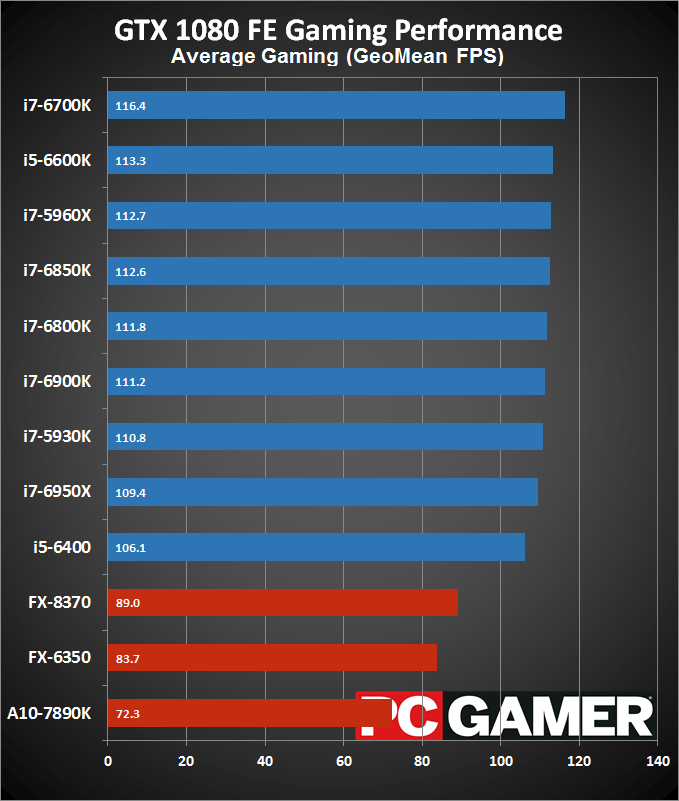
At a high level where I average (technically, I use the geometric mean) all eight game results together, things break down pretty much as expected. The higher clocked i7-6700K comes out on top, followed by the i5-6600K—the Skylake architecture is simply superior to Haswell and Broadwell on a clock-for-clock basis. Meanwhile, the difference between the 'best' (i7-5960X) and 'worst' (i7-6950X) of the Haswell-E and Broadwell-E chips is only three percent, which is practically margin of error. If you were expecting more of a gap between the various Intel processors, even with the mighty GTX 1080, the GPU still ends up being the main bottleneck in most games.
That isn't to say the CPU doesn't matter, as AMD's processors are far off Intel's pace, with the i5-6400 beating the FX-8370 by nearly 20 percent. Don't be too quick to judge AMD as unsuitable for gaming, however, as most owners of FX series processors or AMD APUs aren't going to be running a GTX 1080 (or anything near it). With something a bit more moderate, like an R9 390, the FX series ends up being within a five percent of the Core i7 parts in overall performance. The A10 is still around 15 percent behind Intel's chips (with a rather large 37 percent deficit in Hitman, thanks to DX12's ability to utilize additional CPU cores better than DX11), but most APU users are likely using the APU's graphics.
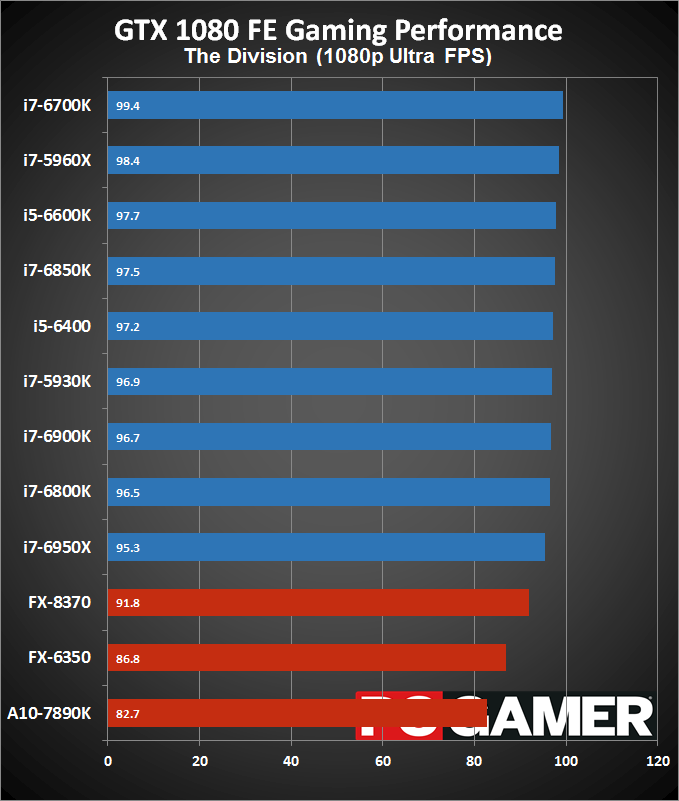
Digging into the individual games, The Division isn't all that demanding when it comes to the CPU, at least in my testing. I use the built-in benchmark, though, so playing the full game may tax the processor more. At stock clocks, AMD's processors prove to be a bit of a bottleneck, but it's not too bad. Meanwhile all of the Intel processors are within spitting distance of each other. The overall winner is the i7-6700K, no doubt helped by its high clock speed, but notice how close the i5-6400 is to its big brother. Broadwell-E and Haswell-E are basically tied, which will be a continuing theme.
One thing that doesn't show up in the frame rate charts is how long the game takes to load, however, particularly the first time you run it on a system. Let me tell you: on the AMD APU, load times in The Division are pretty dismal—like go make yourself a sandwich dismal. It easily took twice as long, if not three times as long, to actually get into the game world on the A10 processor, and I've noticed the same thing in the past when simulating a Core i3. This happens on other games to a certain extent, but The Division is the worst example of long load times in the current test suite.
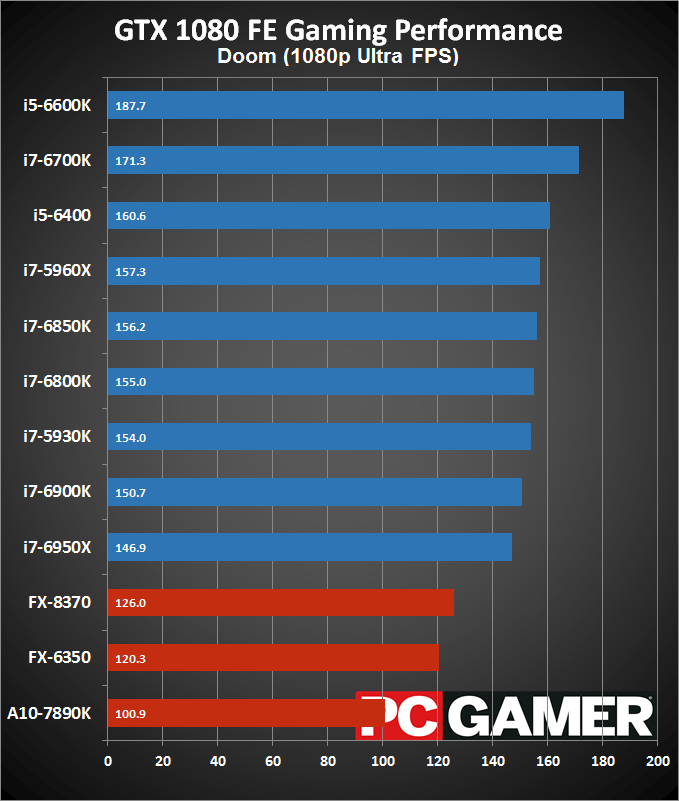
Doom is a game where the CPU definitely matters. AMD's best 'reasonable' CPU manages just 126 fps, while Core i5 is able to hit 161 fps. There's also an interesting anomaly here, in that Hyper-Threading actually hurts performance. Presumably there are cache contention issues or some other form of fighting for limited resources, but the result is that the i5-6600K posts the best performance out of the test CPUs by over 16 fps, and Haswell/Broadwell-E all end up slower than the i5-6400. (Disabling Hyper-Threading in the BIOS 'fixes' this on the Core i7 chips, though you wouldn't want to do this for most situations as it requires a reboot—Doom is very much the exception right now.)
All of this is without Vulkan, however, so things will almost certainly change when the Vulkan patch is out. Sadly, we're still waiting for that day to arrive. I'd expect the FX-series to get a good boost out of Vulkan, and hopefully Hyper-Threading doesn't cause a performance drop after the patch. It's worth pointing out that Doom is also the only OpenGL game currently in the test suite, so perhaps something with that API causes issues with Hyper-Threading, though I don't recall seeing anything like that in the past.
The biggest gaming news, reviews and hardware deals
Keep up to date with the most important stories and the best deals, as picked by the PC Gamer team.
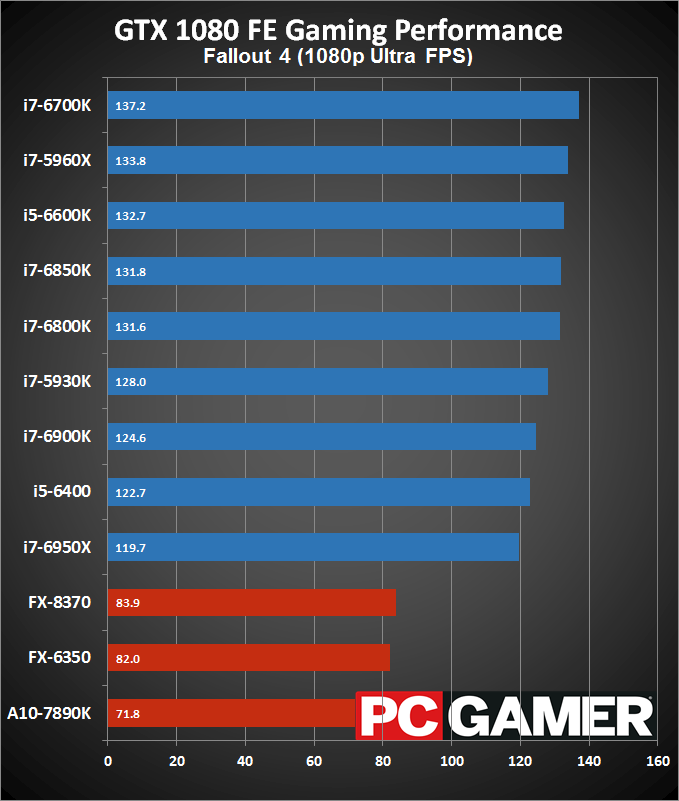
The i7-6700K returns to the top of the stack in Fallout 4, with the i7-5960X taking an interesting second place position. And this isn't the only game where the older Haswell-E part outperforms the new Broadwell-E offerings. AMD again falls short, and more cores will only get you so far. The 6-core and 8-core scores are basically tied, and higher clock speeds in general help more than higher core counts.
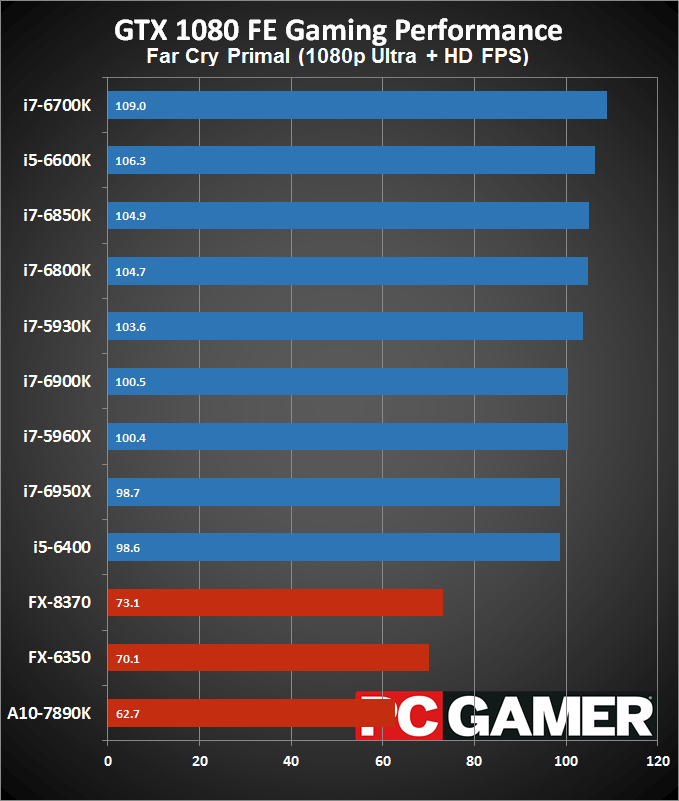
Far Cry Primal continues the pattern, with the unlocked Skylake parts at the top. This time, Broadwell-E manages to take the third and fourth slots, but notice it's the 6-core BDW-E chips. The 8-core and 10-core don't do quite as well, thanks to lower stock clock speeds.
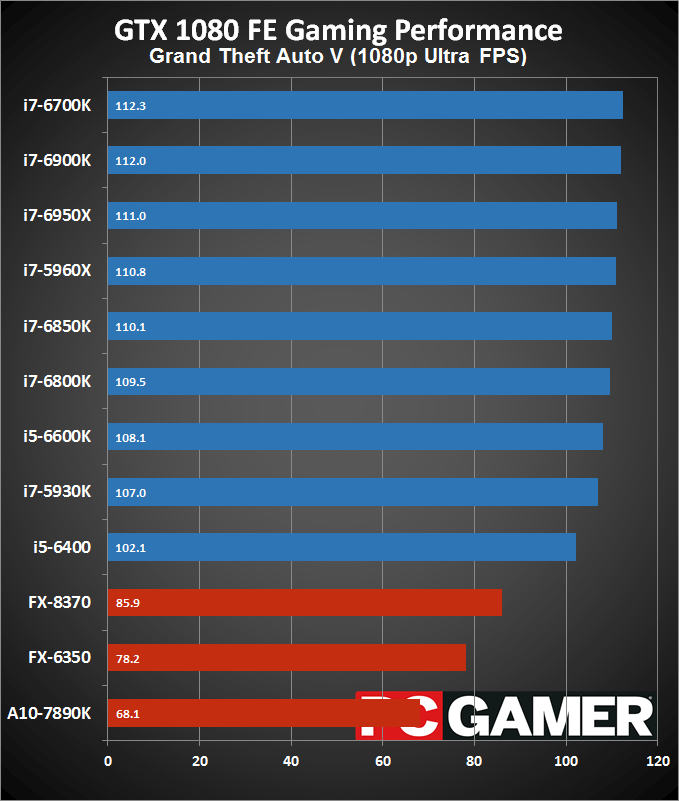
Unlike most of the other games tested, GTAV seems to like core counts almost as much as clock speeds. The 8-core FX-8370 holds a moderate ten percent lead over the 6-core FX-6350, with a 2.5 percent clock speed difference, so the extra Piledriver module is good for a 7.5 percent boost (give or take). There's a bit of variance among the 6-core, 8-core, and 10-core Intel chips, but it's mostly a tie, with the i7-6700K in there as well. i5-6600K and i7-5930K are a few points off the pace, but nothing to really worry about.
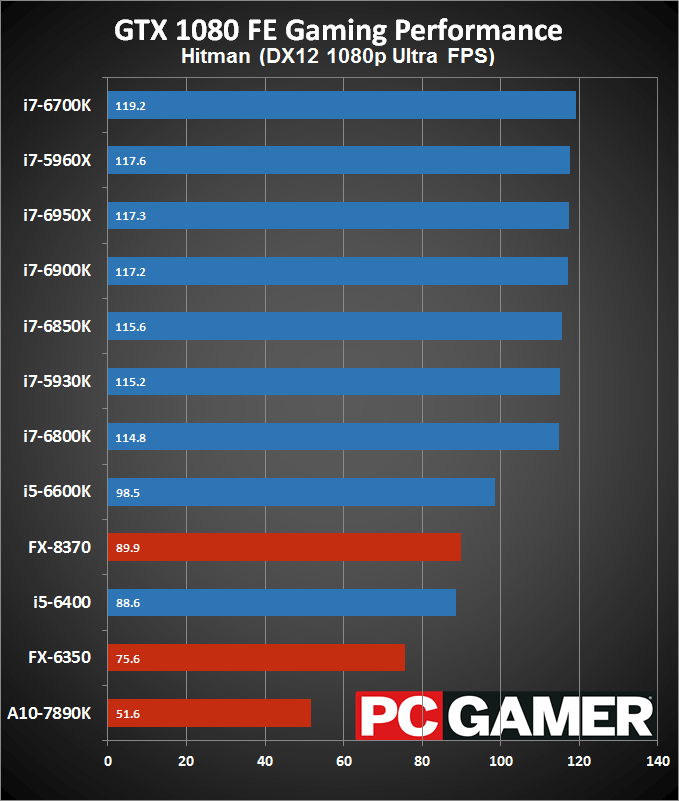
We're running Hitman in DX12 mode, and one of the advantages of DX12 is that it allows for better scaling with multiple CPU cores. That certainly proves to be the case with the AMD FX processors, showing even better scaling than on GTAV—the 8-core part is almost 20 percent faster than the 6-core part. Intel's 8-core and 10-core offerings also do well, though the i7-6700K remains just ahead of them thanks to its superior architecture and clock speed advantage. The i5-6600K meanwhile falls way behind, losing by over 20 percent to the 6700K—easily the largest gap you're likely to see, short of other DX12 games showing similar scaling. This is also the only game tested where the FX-8370 is able to beat the i5-6400, though anecdotally I believe the same thing happens in Ashes of the Singularity.
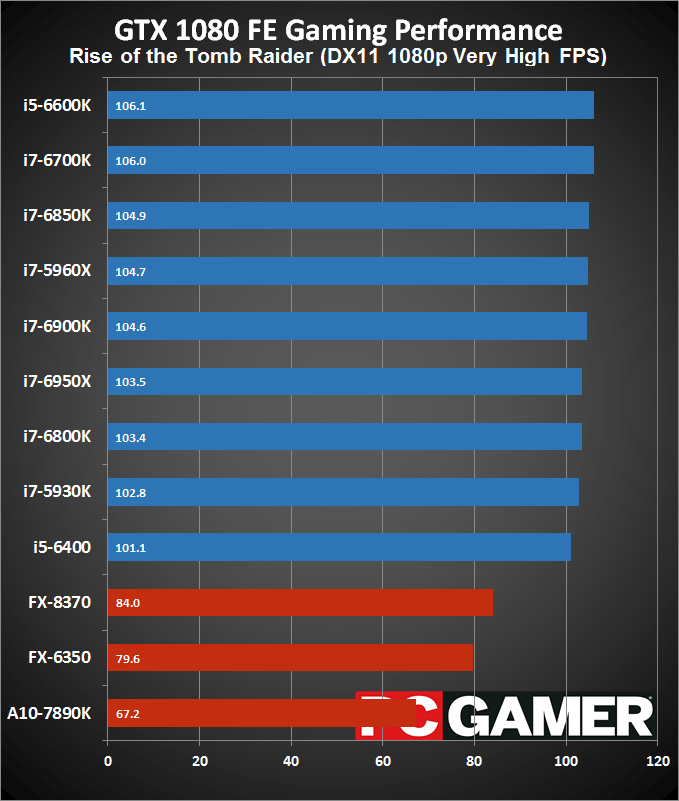
We run Rise of the Tomb Raider in DX11 mode, as the DX12 mode has been slower on all configurations I've previously tested. (Note that I didn't test all the CPUs here in both modes, though, so perhaps DX12 might help some of the slower CPUs.) Anyway, things are basically back to 'normal,' with the Core i5 and i7 parts clustered together and AMD's processors at the bottom.
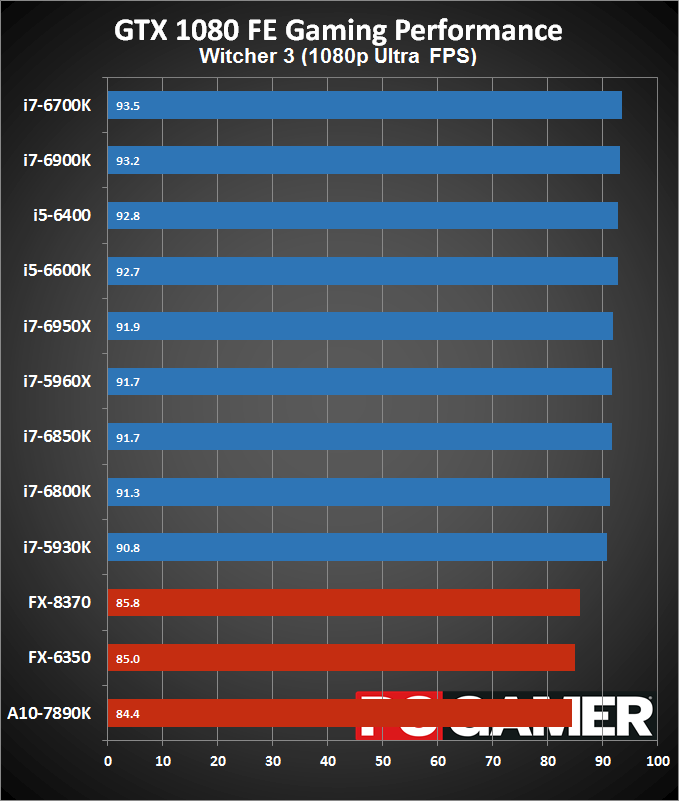
Interestingly, out of all the games tested, The Witcher 3 proves to be the least stressful when it comes to CPU horsepower. It doesn't seem to scale much with additional cores (e.g., the three AMD chips are all close together). Perhaps it's just that the game is more GPU limited than other titles. Anyway, you don't need a killer processor with this game, at least if you're running a single GPU.
Jarred's love of computers dates back to the dark ages when his dad brought home a DOS 2.3 PC and he left his C-64 behind. He eventually built his first custom PC in 1990 with a 286 12MHz, only to discover it was already woefully outdated when Wing Commander was released a few months later. He holds a BS in Computer Science from Brigham Young University and has been working as a tech journalist since 2004, writing for AnandTech, Maximum PC, and PC Gamer. From the first S3 Virge '3D decelerators' to today's GPUs, Jarred keeps up with all the latest graphics trends and is the one to ask about game performance.


